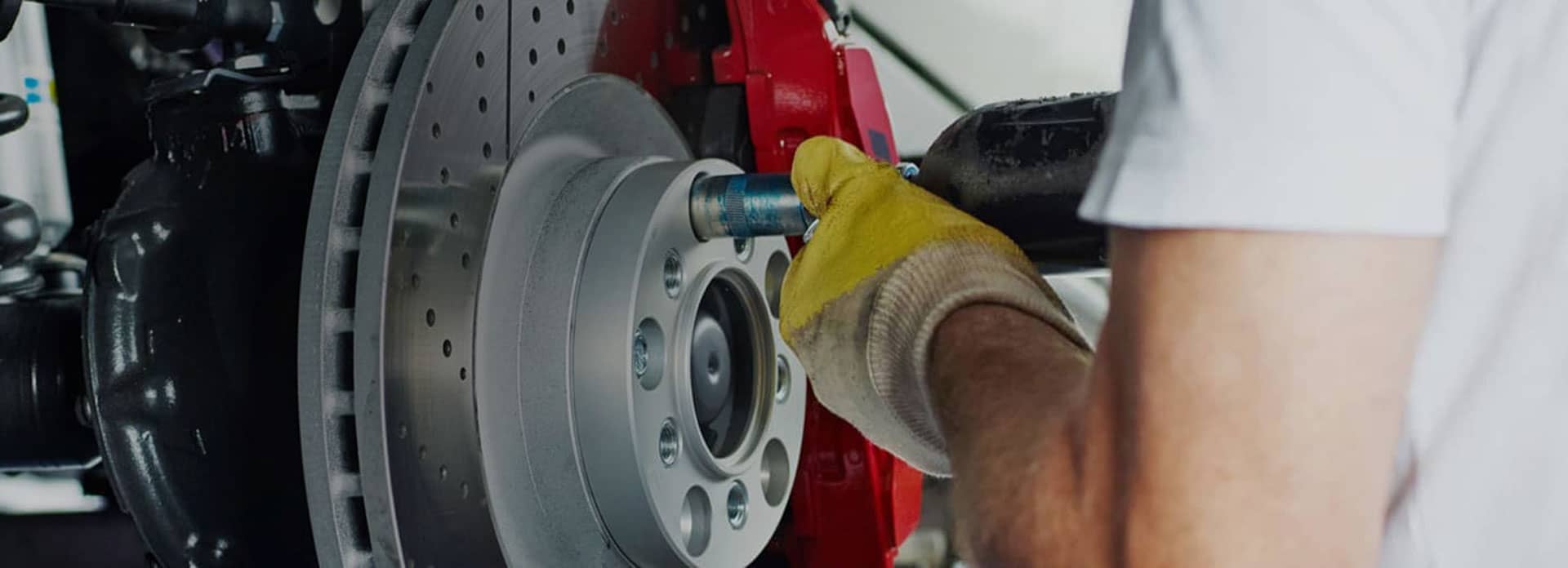
AUTONET TV
Archive for December 2019No Fueling! (Fuel Filler Location)Posted December 29, 2019 10:02 AMIf you've ever gotten in an unfamiliar vehicle, maybe a rental car, you may have pulled up to the gas pump and wondered, "Which side is the fuel filler on?" Here's a tip for you. There is usually a little arrow on the instrument panel near the fuel gauge that points to the side where the fuel filler is. But why are the fuel fillers not all on the same side, anyway? There are lots of reasons. At one time, many manufacturers tried putting them in an easy-to-reach spot: in the center of the vehicle's rear end. Some even hid them behind a hinged license plate door. Cool place, but it turned out not to be a good idea. When a vehicle with a fuel filler in the rear was hit by another vehicle from behind, it was much more prone to catch fire and explode. Safety regulations now dictate that the fuel filler doors be placed within crumple zones and away from where they can drip fuel on hot exhaust pipes or near electrical connections. But why do manufacturers put them on either side? Some say it should be on the side away from the road. That way if you run out of gas and have to add a little from a gas can as your standing at the side of the road, you'll be a little farther away from passing traffic. So some companies from North America and many European firms with left-hand drive put their fillers on the right side. Some manufacturers think convenience for the driver is paramount, so they put their fuel fillers on the driver's side. If you have a vehicle with a cable release for the fuel door inside the cabin, it's usually on the same side as the steering wheel. As you can see, there's no standardization. Fuel doors need regular maintenance such as lubrication, and your gas cap (if your vehicle has one) should seal properly. Have your service facility inspect those regularly. Wherever your fuel filler is, it's obviously important that you can get at it easily because you have to fuel up sometime. Otherwise, you're not going to go too far! autoclinic of brandon Too Hot to Handle (Vehicle Overheating)Posted December 22, 2019 10:52 AMIn the hot weather, seeing steam coming from the engine compartment is something we all dread. No one wants that to happen to them. But if you know the signs of overheating and how to deal with it, you may be able to reduce the risk of damage to your vehicle, maybe even prevent getting stranded on the road. Besides the steam coming out of the engine compartment, here are a few signs of overheating. Your vehicle has a heat gauge that may have a needle that can go into a red zone or up to the "H" (for High) position. You may smell odors, perhaps a burning (could be hot oil) or a sweet smell (engine coolant leaking). When you encounter any of those signs, you know you have to do something to keep the engine as cool as possible to avoid potentially catastrophic damage. Turn off the air conditioning and turn up the heat. While that last part may sound odd, it helps draw heat out of the engine. If you can do it safely, pull off the road to a spot away from traffic. Turn off the engine so it can cool down for a few minutes. You may want to call for help at this point, then switch on the key to "accessory" position to see if the engine has cooled down to the normal range. You may have to have your car towed to a service facility or, if there's one nearby, you may be able to slowly drive to it. But keep your eye on the heat gauge and immediately stop if it starts to overheat again. The best hedge against engine overheating is regular maintenance. When the cooling system and other engine components are working like they should, your chances of an overheated engine are drastically reduced. Your service facility will keep their eyes open for leaking hoses, cracked belts, rusted pipes and other things so they don't fail at the most inopportune time. autoclinic of brandon The Turn Signal Mystery (Turn Signal Problems)Posted December 15, 2019 8:19 AMSome problems are easy to diagnose on a vehicle; others aren't. Figuring out what's wrong with a malfunctioning turn signal sometimes fits into both categories. By the way, if your tempted to just leave your broken blinker broken, remember you can get a ticket for not using them, not to mention you are missing a great chance to communicate your intentions to other drivers on the road. There can be lots of signals that your signals are on the blink. Does only the driver's side signal not work or the passenger's side? Do your hazard signals work? Do the lights illuminate but not flash? Can you see the indicators on the dash blinking? Do your turn signals turn off after you've finished your turn or do they stay on? These are all great clues for the technician. Here's one common symptom to take note of. Your signal all of a sudden starts blinking much more quickly than it used to. It could be a simple as a burned out bulb. But there are many different parts that go into the turn signal system. There are fuses that blow, switches that can fail, flasher modules that go bad and light bulb sockets that can simply get corroded or dirty. When that happens, it's possible there's no contact between the bulb and the socket. So it's understandable how tracking down the source of the problem can involve some detective work. Your service facility has equipment that can nail down the cause of your problems. They may also consult the repair manual. One thing to be aware of: if your vehicle has airbags, they may have to be disabled so they don't accidentally go off. You can make sure your turn signals are working correctly by having them checked by a trained technician. Other drivers will thank you for showing them the courtesy of signaling your intentions. It's a courteous and considerate thing to do, not to mention it makes the road a safer place. autoclinic of brandon Not So Hot in brandonPosted December 8, 2019 10:07 AMWhen the weather turns cold, it's nice to crank up the furnace and enjoy the heat. But if your home's furnace doesn't work, it's not too comfortable. Same goes with your vehicle. When the heater's not working, things can get miserable. It could also signal some major problems, which we'll discuss later. A vehicle's heating system is fairly complicated. It's made up of several parts, including a blower motor/fan, a heater core and some mechanical and electrical components. In basic terms, a vehicle's engine warms up coolant which is then sent to the heater core (which is kind of like a small radiator) behind the dash. That blower motor sends cold air through the heater core which heats up the air. Voila! Heat. Diagnosing problems in this system takes a trained mechanic because of the different possible issues. Your heater core may need replacing; they are sometimes in tight spots and may be difficult to work on. Another possible problem could be a defective thermostat, which regulates how the coolant flows through the engine. You may have a leak somewhere in your cooling system. Those leaks may be something as simple as a detached hose clamp or as serious as a bad head gasket. A knowledgeable technician at autoclinic of brandon will be able to track the problems down. For those reasons, it's wise to get your vehicle's heating system repaired. Not only can driving an unheated vehicle on a cold day freeze your fingers, some related engine problems that are not repaired could leave you stranded. Smart drivers keep up the maintenance on their vehicle's cooling system; it's a hot tip to prevent a cold vehicle. autoclinic of brandon Not-So-Common Sense (Sensor Failures)Posted December 1, 2019 10:59 AMSo your vehicle won't start. What's the first thing that comes to mind? Battery dead? Starter motor worn out? Out of gas? Well, those are all reasons that make sense. But your vehicle may be refusing to start because one of its computers is being warned that to do so might damage it. Here's how that works. You have lots of computers in your vehicle. They need to know the status of things so there are several sensors monitoring various things going on. These sensors send information to the computers that adjust the fuel and air mixture so you don't waste fuel. They know when things aren't quite right and prevent you from starting your engine if that's going to damage it. Other sensors make sure the coolant is the right temperature, check to see you are not polluting the air and make sure other electronic components are performing their tasks correctly. Here's an example of a sensor doing its job. Your engine needs oil to lubricate metal components so the friction doesn't damage them. Your engine has an oil pressure sensor that tells a computer called the Electronic Control Unit (ECU) if things are good to go or if there's something wrong, maybe the oil pressure is too low to keep things lubricated. If it is, it gives a signal for the vehicle not to start, protecting the engine. Of course, the sensors can go bad, too, with some of the same results. And so someone has to figure out if it's the sensor that's failed or if it really has detected a problem. That is the challenge for technicians with specialized equipment to decipher the signs. If a bad sensor is found, it may need to be replaced. Sometimes a thorough cleaning can do the trick. In either case, your service facility can track down the problem and get you back on the road. Makes sense, doesn't it? autoclinic of brandon | ||
SearchArchiveDecember 2009 (3)January 2010 (3) February 2010 (4) March 2010 (4) April 2010 (5) May 2010 (2) June 2010 (1) July 2010 (4) August 2010 (4) September 2010 (3) October 2010 (3) November 2010 (4) December 2010 (5) January 2011 (4) February 2011 (4) March 2011 (5) April 2011 (4) May 2011 (4) June 2011 (1) August 2011 (3) September 2011 (3) October 2011 (2) December 2011 (4) February 2012 (2) March 2012 (4) April 2012 (4) May 2012 (1) June 2012 (3) July 2012 (1) August 2012 (1) November 2012 (1) December 2012 (2) March 2013 (1) April 2013 (4) May 2013 (1) September 2013 (1) October 2013 (5) November 2013 (2) January 2014 (2) February 2014 (4) March 2014 (1) July 2014 (4) August 2014 (7) September 2014 (4) October 2014 (5) November 2014 (4) December 2014 (4) January 2015 (5) February 2015 (4) March 2015 (4) April 2015 (4) May 2015 (3) June 2015 (5) July 2015 (1) September 2015 (2) October 2015 (4) November 2015 (5) December 2015 (2) February 2016 (2) March 2016 (3) April 2016 (4) May 2016 (5) June 2016 (4) July 2016 (5) August 2016 (4) September 2016 (4) October 2016 (4) November 2016 (5) December 2016 (4) January 2017 (5) February 2017 (4) March 2017 (4) April 2017 (4) May 2017 (5) June 2017 (4) July 2017 (5) August 2017 (3) September 2017 (3) October 2017 (4) November 2017 (5) December 2017 (3) January 2018 (5) February 2018 (4) March 2018 (4) April 2018 (5) May 2018 (4) June 2018 (3) July 2018 (5) August 2018 (4) September 2018 (5) October 2018 (4) November 2018 (4) December 2018 (5) January 2019 (5) February 2019 (4) March 2019 (5) April 2019 (4) May 2019 (4) June 2019 (5) July 2019 (4) August 2019 (4) September 2019 (5) October 2019 (4) November 2019 (4) December 2019 (5) January 2020 (5) February 2020 (4) March 2020 (5) April 2020 (4) May 2020 (5) June 2020 (4) July 2020 (4) August 2020 (5) September 2020 (4) October 2020 (4) November 2020 (5) December 2020 (4) January 2021 (6) February 2021 (4) March 2021 (4) April 2021 (4) May 2021 (5) June 2021 (4) July 2021 (4) August 2021 (5) September 2021 (4) October 2021 (5) November 2021 (4) December 2021 (4) January 2022 (6) February 2022 (4) March 2022 (4) April 2022 (4) May 2022 (5) June 2022 (4) July 2022 (5) August 2022 (2) September 2022 (4) October 2022 (5) November 2022 (4) December 2022 (4) January 2023 (5) February 2023 (4) March 2023 (4) April 2023 (5) May 2023 (4) June 2023 (4) July 2023 (5) August 2023 (4) September 2023 (3) October 2023 (3) January 2024 (1) February 2024 (4) | CategoriesAir Conditioning (17)Alignment (16)Alternator (6)Auto Safety (6)Automotive News (8)Battery (20)Brake Service (4)Brakes (22)Cabin Air Filter (8)Check Engine Light (6)Cooling System (19)Customer Detective Work (1)Dashboard (3)Diagnostics (5)Diesel Maintenance (1)Differential Service (3)Drive Train (9)Emergency Items (1)Engine Air Filter (2)Exhaust (12)Fluids (16)Fuel Economy (10)Fuel Pump (1)Fuel Saving Tip: Slow Down (2)Fuel System (46)Headlamps (6)Inspection (10)Keys to a long lasting vehicle (4)Maintenance (52)Monitoring System (3)Oil Change (7)Older Vehicles (4)Parts (7)PCV Valve (2)Safe Driving (1)Safety (6)Serpentine Belt (6)Service Intervals (9)Service Standards (12)Shocks & Struts (9)Shocks and Struts (1)Spark Plugs (2)Steering (14)Suspension (3)Timing Belt (6)Tire Rotation and Balancing (3)Tires (10)Tires and Wheels (40)TPMS (3)Transfer Case Service (1)Transmission (11)Trip Inspection (4)Warranty (1)Water Pump (1)What Customers Should Know (81)Wheel Bearings (1)Windshield Wipers (9)Winter Prep (7)Winter Tires (1) | |

Get free Coupons
Take advantage of these great offers!



.png)






